

La motivación del signo lingüístico. Simbolismo%20sonoro. Arbitrariness, iconicity and systematicity in language. Trends in Cognitive Sciences has just published a new paper by me with Damián Blasi, Gary Lupyan, Morten Christiansen and Padraic Monaghan.
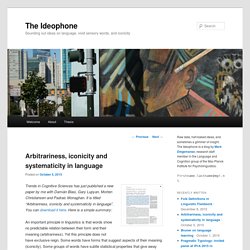
It is titled “Arbitrariness, iconicity and systematicity in language”. You can download it here. Here is a simple summary: Sound rules. « previous post | next post » Stephen Halsey, who is spending the year in Taiwan doing research, observed an interesting linguistic phenomenon that shows the predominance of sound over symbol, even in the writing of Chinese, where the symbols are complex and semantically "heavy" in comparison to phonetic scripts like the Roman alphabet or bopomofo / zhuyin fuhao (Mandarin phonetic symbols), where the symbols are simple and semantically "light".
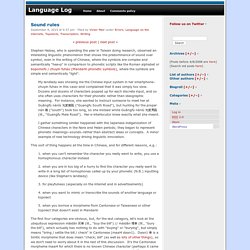
My landlady was showing me the Chinese input system in her smartphone–zhuyin fuhao in this case–and complained that it was simply too slow. Dozens and dozens of characters popped up for each discrete input, and so she often uses characters for their phonetic rather than ideographic meaning. For instance, she wanted to instruct someone to meet her at Guāngfù nánlù 光复南路 ("Guangfu South Road"), but hunting for the proper nán 南 ("south") took too long, so she instead wrote Guāngfù nánlù 光复男路 (lit., "Guangfu Male Road"). [h.t. Phonaesthemes and sound symbolism in Swedish brand names. Highlights Phonaesthemes are used in brand names to different degrees.
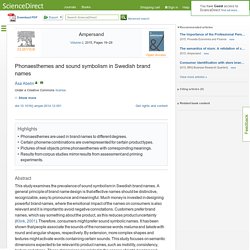
Certain phoneme combinations are overrepresented for certain product types. Pictures of real objects prime phonaesthemes with corresponding meanings. Results from corpus studies mirror results from assessment and priming experiments. Importancia de los fonestemas en el campo fonético-fonológico y morfológico. Palabras e ideas afines relacionadas con la palabra SONIDO%1. Grupos consonánticos. Como sabemos nuestro vocabulario se encuentra conformado por palabras y estas, a su vez, por vocales y consonantes.

En esta sección te darás cuenta que al interior de una palabra se agrupan algunas consonantes… ¡sí! , grupos de consonantes. Te invitamos a conocerlas y a divertirte con este nuevo tipo de sonidos. Trigo, grupo consonántico tr. Armando Francesconi: La traducción de los componentes fonosimbólicos del lenguaje- nº 48 Espéculo. El Universo Kiki- Bouba: Ideaestesia, Empatía y Neuromárketing - Emilio Gómez Milán, Oscar Iborra Martínez, María José de Córdoba Serrano. El Universo Kiki- Bouba: Ideaestesia, Empatía y Neuromárketing - Emilio Gómez Milán, Oscar Iborra Martínez, María José de Córdoba Serrano. Importancia de los fonestemas en el campo fonético-fonológico y morfológico. El archivo PDF que ha seleccionado se debe cargar aquí si su navegador tiene instalado un conector de lectura de PDF (por ejemplo, una versión reciente de Adobe Acrobat Reader).

Asimismo, también puede descargar el archivo PDF directamente a su ordenador para abrirlo con un lector de PDF. Para descargar el PDF, haga clic en el enlace de descarga. Si desea obtener más información acerca de cómo imprimir, guardar y trabajar con archivos PDF, Highwire Press cuenta con una útil lista de preguntas frecuentes sobre archivos PDF. Dictionary of English Phonesthemes Part 1. All Things Linguistic. Psicolingüística - Francisco Valle Arroyo - Google Books. Kiki or bouba? In search of language's missing link - life - 18 July 2011. Read full article Continue reading page |1|2|3|4 Before reading this article, you might like to try our test: Which of these words sounds bigger?

Through the looking glass, Lewis Carroll's Alice stumbles upon an enormous egg-shaped figure celebrating his un-birthday. She tries to introduce herself: "It's a stupid name enough! " "Must a name mean something? " "Of course it must," Humpty Dumpty said with a short laugh: "My name means the shape I am - and a good handsome shape it is, too. PURE whimsy, you might think. Yet a spate of recent studies challenge this idea. More than 2000 years before Carroll suggested words might have some inherent meaning, Plato recorded a dialogue between two of Socrates's friends, Cratylus and Hermogenes. The Greek philosophers never resolved the issue, but two millennia later the Swiss linguist Ferdinand de Saussure seemed to have done so. The world of linguistics was mostly convinced, but a few people still challenged the status quo.
More From New Scientist. The shape of boubas: sound–shape correspondences in toddlers and adults - Maurer - 2006 - Developmental Science. THE FITNESS OF NAMES TO DRAWINGS. A CROSS-CULTURAL STUDY IN TANGANYIKA - DAVIS - 2011 - British Journal of Psychology. Url?sa=t&rct=j&q=&esrc=s&source=web&cd=1&ved=0CB8QFjAA&url=https%3A%2F%2Fwww.ur.edu.pl%2Ffile%2F1230%2Fsar_v1_02.pdf&ei=2XV5VMXtM8qVNu-egYgP&usg=AFQjCNGJNBrb1n9hc0AYgWUFJyj4zX9cjA&bvm=bv.80642063,d. Studies in Sound Symbolism (tesis suecia) PHONESTHEMES IN SWEDISH. Advances in the Cross-Lingu istic Study of Ideophones. The non-arbitrary aspect of language: The iconicity of onomatopoeic words in Thai. Sound Symbolism introduction. Japanese Sound-Symbolism Facilitates Word Learning in English-Speaking Children - Kantartzis - 2011 - Cognitive Science.
Abstract.

Iconicity as a General Property of Language: Evidence from Spoken and Signed Languages. Arbitrariness in Language: The Received View The relation between words and real-world referents has intrigued scholars since antiquity.
Early debates centered on the origin of words (as names for things), specifically, on the nature of their relation to the things they stand for. In Plato’s Cratylus, the oldest documented of these debates, Socrates is asked to contemplate the question of whether names belong to their objects “naturally” or “conventionally.” The latter of these two possibilities, namely that form and meaning are linked by convention and tradition alone, has come to dominate our modern thinking about language. Words, and more generally language as a symbolic system, are conceived of as being arbitrarily related to the world. Today, no one would subscribe to the idea of an actual “natural” connection between linguistic signs and their denotata. The Project Gutenberg eBook of Language by Edward Sapir.
Testing Psychological Reality of Phonaesthemes with Masked Priming. El simbolismo fónico de los verbos expresivos en la novela finlandesa Juoksuhaudantie y su traducción al español. El simbolismo fónico de los verbos expresivos en la novela finlandesa Juoksuhaudantie y su traducción al español Doria JavaScript is disabled for your browser.
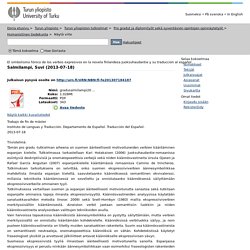
El Universo Kiki- Bouba: Ideaestesia, Empatía y Neuromárketing - Emilio Gómez Milán, Oscar Iborra Martínez, María José de Córdoba Serrano. THE PSYCHOLOGICAL REALITY OF PHONAESTHEMES. Sound Symbolism.
Simbolismo sonoro.pdf. Phonestheme. A phonestheme is different from a morpheme because it does not meet the normal criterion of compositionality.
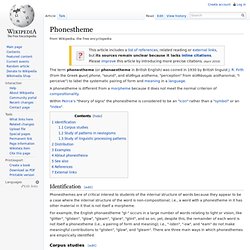
Identification[edit] Phonesthemes are of critical interest to students of the internal structure of words because they appear to be a case where the internal structure of the word is non-compositional; i.e., a word with a phonestheme in it has other material in it that is not itself a morpheme. For example, the English phonaestheme "gl-" occurs in a large number of words relating to light or vision, like "glitter", "glisten", "glow", "gleam", "glare", "glint", and so on; yet, despite this, the remainder of each word is not itself a phonestheme (i.e., a pairing of form and meaning); i.e., "-isten", "-ow", and "eam" do not make meaningful contributions to "glisten", "glow", and "gleam". There are three main ways in which phonesthemes are empirically identified. Corpus studies[edit] Ideophone. Not to be confused with Idiophone, a class of musical instruments.
Ideophones are words that evoke an idea in sound, often a vivid impression of certain sensations or sensory perceptions, e.g. sound, movement, color, shape, or action. Ideophones are found in many of the world's languages, though they are relatively uncommon in Western languages (Nuckolls 2004). The word class of ideophones is sometimes called phonosemantic to indicate that it is not a grammatical word class in the traditional sense of the word (like 'verb' or 'noun'), but rather a lexical class based on the special relation between form and meaning exhibited by ideophones.
In the discipline of linguistics, ideophones have long been overlooked or treated as mysterious words (Voeltz and Kilian-Hatz 2001:2), though a recent surge of interest in sound symbolism, iconicity and linguistic diversity has brought them renewed attention (Imai et al. 2008, Güldemann 2008, Gasser et al. 2010, Nuckolls 1996). Characteristics[edit] Phonological iconicity. Introduction Linguistic theory widely adopts Saussure's (1959) essential notion of an arbitrary relation between signifier and signified.
While exceptions to this rule have been suggested outside the linguistic mainstream (Jakobson and Waugh, 1979; Tsur, 1992, 1997; Hinton et al., 1994; Volke, 2007; Schrott and Jacobs, 2011), most psycholinguistic models of lexical retrieval and production (e.g., Dell and O'Seaghdha, 1992; Levelt et al., 1999) incorporate arbitrariness as a fundamental feature. However, recent research posits motivated sound-meaning mappings (see Perniss et al., 2010, for review), that according to Peirce's prolific typology of semiotic elements (Peirce, 1931; see Liszka, 1996 for an overview) classify as iconic or indexical rather than symbolic, involving structural resemblance, or natural association between signifier and signified.
We will first focus on onomatopoiea and ideophones as well-established sound-symbolic inventories in a variety of languages. Onomatopoeia.